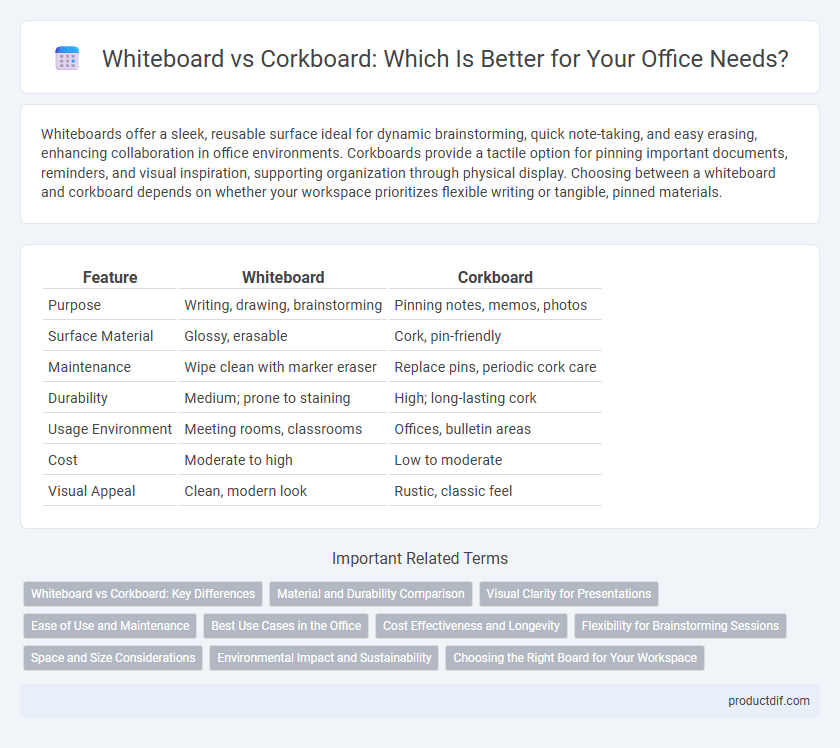Whiteboards offer a sleek, reusable surface ideal for dynamic brainstorming, quick note-taking, and easy erasing, enhancing collaboration in office environments. Corkboards provide a tactile option for pinning important documents, reminders, and visual inspiration, supporting organization through physical display. Choosing between a whiteboard and corkboard depends on whether your workspace prioritizes flexible writing or tangible, pinned materials.
Table of Comparison
| Feature | Whiteboard | Corkboard |
|---|---|---|
| Purpose | Writing, drawing, brainstorming | Pinning notes, memos, photos |
| Surface Material | Glossy, erasable | Cork, pin-friendly |
| Maintenance | Wipe clean with marker eraser | Replace pins, periodic cork care |
| Durability | Medium; prone to staining | High; long-lasting cork |
| Usage Environment | Meeting rooms, classrooms | Offices, bulletin areas |
| Cost | Moderate to high | Low to moderate |
| Visual Appeal | Clean, modern look | Rustic, classic feel |
Whiteboard vs Corkboard: Key Differences
Whiteboards offer a smooth, erasable surface ideal for dynamic presentations and note-taking, while corkboards provide a pin-friendly texture suited for displaying physical documents and memos. Whiteboards support dry-erase markers and are easily wiped clean, making them reusable and versatile in meeting rooms and classrooms. Corkboards require push pins and do not allow for easy editing of content, serving better as a static display for notices and reminders.
Material and Durability Comparison
Whiteboards are typically made from materials such as melamine, painted steel, or glass, providing a smooth, durable surface resistant to stains and scratches, ideal for frequent writing and erasing. Corkboards consist of natural cork material that offers good pin-hold strength but can degrade over time with heavy use and exposure to moisture. When evaluating durability, whiteboards generally outperform corkboards in longevity and maintenance, making them more suitable for dynamic office environments.
Visual Clarity for Presentations
Whiteboards provide superior visual clarity for presentations by offering a smooth, reflective surface that enhances marker visibility and color contrast, making information easy to read from a distance. Corkboards, while useful for pinning notes, lack the high-contrast display necessary for dynamic presentations and can appear cluttered and less professional. Choosing a whiteboard improves audience engagement through clear, legible visuals and the flexibility to erase and update content quickly.
Ease of Use and Maintenance
Whiteboards offer effortless use with smooth writing surfaces and simple erasing, making them ideal for frequent updates and brainstorming sessions. Corkboards require pinning and unpinning items, which can be less efficient and may cause damage to documents over time. Maintenance of whiteboards involves regular cleaning with appropriate solvents to prevent staining, whereas corkboards need minimal upkeep but can degrade with heavy use.
Best Use Cases in the Office
Whiteboards excel in dynamic office settings, ideal for brainstorming sessions, team meetings, and project planning due to their reusability and ease of updating information. Corkboards are best suited for displaying permanent or semi-permanent notices, calendars, and important documents, providing a tactile and organized way to showcase physical items. Combining both tools enhances office productivity by catering to diverse communication needs, balancing flexibility with visual organization.
Cost Effectiveness and Longevity
Whiteboards offer high cost effectiveness due to their reusable surface, reducing the need for frequent replacements compared to corkboards, which require continuous purchase of pins and maintenance. In terms of longevity, whiteboards typically last longer as their smooth, non-porous surface resists wear and stains, while corkboards can deteriorate from repeated pin use. Choosing between the two depends on budget constraints and the intended frequency of use, with whiteboards providing a more durable and economical option for long-term office needs.
Flexibility for Brainstorming Sessions
Whiteboards offer greater flexibility for brainstorming sessions by allowing users to quickly write, erase, and reorganize ideas in real time, making them ideal for dynamic and iterative discussions. Corkboards provide a tactile way to pin notes and visual aids, but they lack the immediate editability of whiteboards. For teams requiring fast, fluid idea generation and modification, whiteboards are the preferred choice.
Space and Size Considerations
Whiteboards typically offer larger writing surfaces ideal for collaborative environments, while corkboards provide flexible pinning space suitable for smaller notes and visual reminders. In compact offices, corkboards save wall space with their often thinner profiles, whereas whiteboards may require more installation room due to their bulkier frames. Choosing between whiteboard and corkboard depends on available wall dimensions and the primary function, balancing space constraints with usability needs.
Environmental Impact and Sustainability
Whiteboards, often made from melamine or steel with plastic coatings, tend to have a higher environmental footprint due to non-recyclable materials and shorter lifespans, whereas corkboards utilize natural, renewable cork harvested from cork oak trees, promoting sustainability through biodegradability and carbon sequestration. Cork production supports ecological balance by preserving cork oak habitats, which helps maintain biodiversity and reduce soil erosion. Choosing corkboards over whiteboards aligns with eco-friendly office practices by minimizing chemical waste and reducing reliance on synthetic components.
Choosing the Right Board for Your Workspace
Selecting the right board for your workspace depends on your specific needs: whiteboards offer a smooth, erasable surface ideal for brainstorming and presentations, while corkboards provide a tactile way to pin important documents and reminders. Consider the frequency of updates and the type of information you need to display, as whiteboards support dynamic content changes whereas corkboards are better suited for static notices. Workspace size and aesthetics also influence the choice, with whiteboards typically offering a sleek, modern look compared to the traditional appearance of corkboards.
Whiteboard vs Corkboard Infographic

 productdif.com
productdif.com